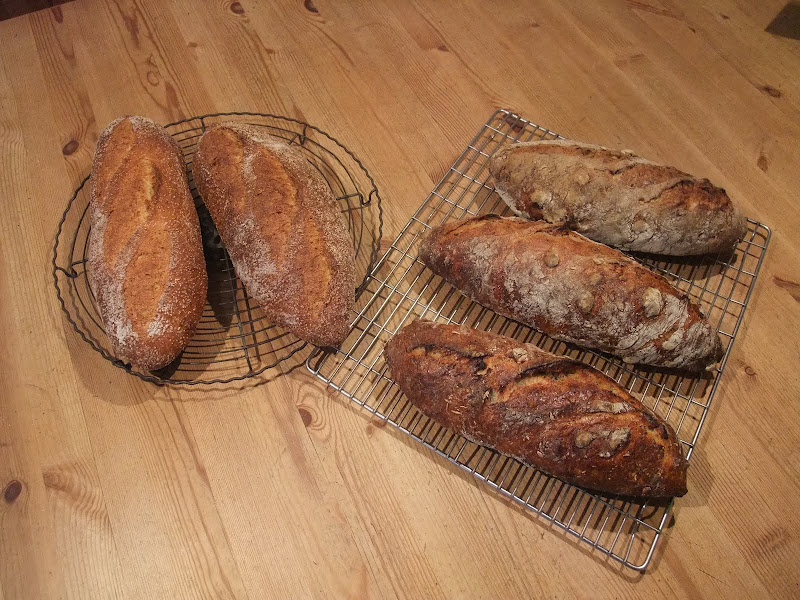
Isn't one of the best things to sit down with friends for a simple dinner? Last night we had two kinds of bread, butter, lots of cheese and a swiss style müsli, the Birchermüsli. I was so satisfied. And the others seemed to enjoy it as well. It always makes me so happy and proud when other people enjoy my baking and I think I'm very lucky that I've got such friends and family members who are willing to try new things. Howwould I be able to bake otherwise?!
After the Buckwheat Apple Sourdough I felt that autumn had come. Even though I'm very much a summer person, I decided to make the best out of it and bake some more seasonal breads. I made an old favorite again, the Potato-Nut Bread from Southern Tyrol and created a formula for a Pumpkin-amaranth bread. I shared the recipe for the Potato-Nut Bread a few monts ago on here and David has baked the Potato-Nut Bread a couple weeks ago and had very nice results.
The Potato-Nut-Bread is a very rustic loaf. The crust looks every time very wild and I always get a nice crunch when baking this bread. It has a good keeping quality due to the potatoes, which also make the inside very soft and tender. (If there weren't any crunchy nuts ;) .) This time, I even achieved somewhat of an oven spring, which I've found hard to achieve in the past. But probably I was just not doing it right, this is one of the recipes I started my sourdough baking with. From all the times that I've baked this bread, this time it was the most successful time! Yeyy! I might could have let it proof somewhat longer after the shaping though. Don't be shy with the coriander - I think, two teaspoons is the perfect amount. (In the original recipe it's even two tablespoons, but then it's very overpowering.)
The pumpkin-Amaranth bread . . . is yellow! Sadly, I couldn't notice any pumpkin flavor. But the color is great, I think I'll bake with pumpkin again. maybe I won't blend it completely and leave some chunks the next time. The toasted amaranth provided a very tasty note! I was frustrated though because I forgot to roll the shaped batard in amaranth. Imagine how nice this crust would have been! Why am I so oblivious. . . I wasn't 100 %satisfied with the crust, it softened during the cooling. The bread was very light and pillowy.
Potato-Nut Bread from Southern Tyrol
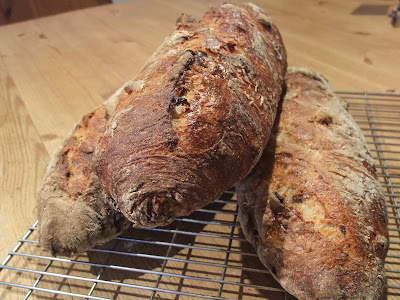
Ingredients
Liquid levain
- 80 g whole rye flour
- 100 g water
- 20 g mature starter
Final dough
- All of the liquid levain
- 400 g potatoes, peeled
- 500 g bread flour
- 250 ml water
- 11 g salt
- 2 tsp ground coriander
- 100 g walnuts
- 100 g hazelnuts
- Prepare the liquid levain the night before you bake.
- On the next day, cook the potatoes with just a little bit of water. Drain the excess water and let the potatoes cool somewhat. Mash the potatoes.
- chopp the walnuts and the hazelnuts roughly and toast the nuts until fragrant but not burned. Rub the peels of the hazelnuts off.
- Mix the liquid levain with the water, the potato mash and the flour to a shaggy mass. Let it autolyse for about 30 minutes.
- Add the coriander and salt and mix them into the dough. Knead in your mixer for at least 10 minutes. The dough is very sticky, don’t add any additional flour though! It does not clean off the sides completely.
- Transfer the dough to a floured board and, with well-floured hands, stretch it into a 14 inch square. Distribute the nuts over the dough, roll it up and knead for a couple minutes to get the nuts evenly distributed in the dough.
- Gather the dough into a ball and place it in a large, lightly oiled bowl. Cover the bowl.
- Ferment the dough until it has doubled and is puffy, with stretch and folds every 40 minutes. I folded the dough three times, it fermented somewhat longer than two hours.
- Transfer the dough to a well-floured bench. Divide it into two till three equal pieces. Pre-shape into logs. Dust with flour and cover with plasti-crap. Let the dough rest for 10-20 minutes.
- Form the pieces into bâtards and place them on lightly floured parchment paper. Dust again with flour and cover with plasti-crap.
- Proof the loaves until they are about 1.5 times their original size.
- 45-60 minutes before baking, place a baking stone in the oven and make preparations for your oven steaming method of choice. Pre-heat the oven to 430F.
- Bake with steam for 10 minutes, then in a dry oven for another 20 minutes. If the loaves seem to be getting dark too fast turn the oven down 10-20 degrees.
- Bake until the internal temperature is 205F. Remove the loaves to a cooling rack.
- Cool completely before slicing.
@ David, I copied and adapted your write down of this formula. Is that okay? I made some things differently than you. For instance I used a whole rye sourdough and I cut down on the hazelnuts. In my opinion, a total of 200 g is enough. The bread is still very rich on nuts.
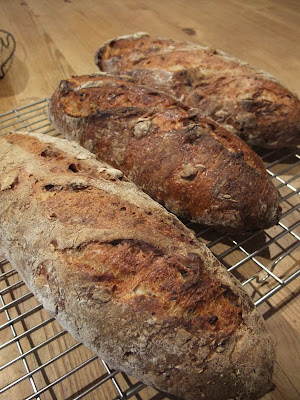

The second bread, the Pumpkin-Amaranth Bread, I made up myself. I found a bag of organic Amaranth the other day in a shop and couldn't resist. On the same day, I prepared a roasted pumpkin salad and thought, that I could use pumpkin in an other way than just always seeds. I cooked some pumpkin pieces with a tiny amount of water and purreed it and stored it in the fridge until today.
Pumpkin-Amaranth Bread
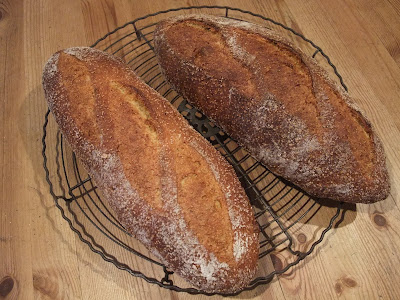
Ingredients
Preferment
- 100 g bread flour
- 1/10 tsp instant yeast
- 57 ml water
Soaker
- 70 g amaranth, toasted until fragrant
- 80 g hot water
Final dough
- All of the preferment, in chunks
- soaker
- 240 g pumpkin, cooked and pureed, cooled
- 250 g bread flour
- 65 g water
- 50 g amaranth flour
- 4 g instant yeast
- 9 g salt
- optional: amaranth for a crust coating
- Mix the ingredients for the preferment the night before you bake.
- At the same time, toast the amaranth grains until they are fragrant.
- The next day, pour 80 ml hot water over the amaranth, let it cool of somewhat.
- Mix all of the preferment, the pumpkin puree, the bread flour and the water and let this shaggy mass autolyse for 30 minutes.
- Add the salt and the instant yeast and knead in a machine until the gluten is developed. Then incorporate the soaked amaranth (some hand work is probably needed).
- Let the dough ferment until doubled in size, with two folds every half hour
- Divide the batch into two equal pieces and preshape. Let them rest for about 10 minutes, then shape into batards. you might want to roll the loaves in amaranth grains to achieve an interesting crust.
- Let them proof for about an hour, until they seem to be ready to go into the oven.
- Slash and bake in the preheated oven (430°) on a baking stone with steam for about 30- 40 minutes

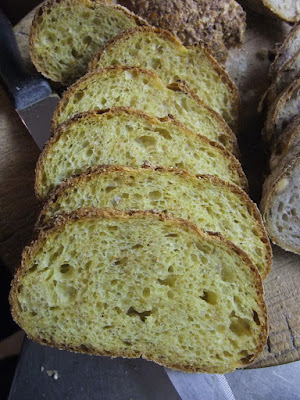
Salome (Happy not just because of her breads, but also because she passed the acceptance test for her school's Proficiency English course (aiming at the Cambridge Proficiency Certificate). Probably as well because I get to use my English here all the time. Thank you folks and keep correcting me!)






